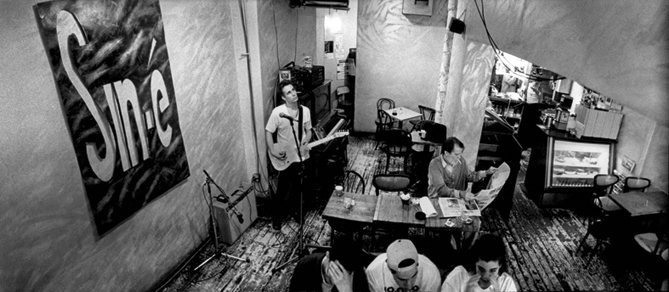Sin-é: Mixing the East Village, Irish Stew, and Live Music

In honor of Irish-American Heritage Month, it’s worth remembering the cultural legacy of Sin-é (Gaelic for that’s it), a former music venue and café located at 122 St. Mark’s Place. Sin-é opened its doors in the East Village in 1989 thanks to Irish immigrant Shane Doyle, and early on became a regular fixture for fans of poetry and anti-folk music in the neighborhood. The venue’s first physical location on St. Mark’s Place existed from 1989 until 1996, then reopened in Williamsburg in 2000, and finally moved to its last physical location on the Lower East Side from 2001 before finally closing its doors in 2007.
The landscape of the East Village’s thriving venues for nightlife and music in the early 1990s was simply unparalleled, with a roster of iconic locations such as the Pyramid Club, Webster Hall, and CBGB. Live music, specifically rock, had been a staple and cultural cornerstone of the neighborhood for decades.

However, Sin-é carved out its unique identity as an intimate performance space for young independent artists and writers to creatively flourish, hone their craft, and cultivate a community. Where else in the East Village could you find a venue where the owner would cook up a batch of Irish stew over in his apartment on Seventh Street and then carry it over in a large pot to serve to audience members?

(Wall of Sound Gallery – Jeff Buckley at Sin-é in 1993)
Located off of Tompkins Square Park, Sin-é’s first location boasted a sole cappuccino machine and only a handful of tables and microphone stands. Sin-é quickly proved that its small capacity size and limited amenities did not dictate the expansive talent that would dominate its stage throughout the early 1990s. Sin-é was instrumental in showcasing noted Irish musicians such as Sinéad O’Connor, Shane MacGowan, and Susan McKeown. The venue also boasted regular poetry readings by significant writers and poets such as Marianne Faithfull and Allen Ginsberg.
This was also one of the venues that singer Jeff Buckley performed at early in his career after moving to New York City and later the East Village in the early 1990s. Buckley’s popular Monday night residency became a hit with fans, and his storied performances at Sin-é would eventually culminate in Buckley’s live EP, Live at Sin-é, which was released in 1993. Live at Sin-é is Jeff Buckley at his rawest, true form in his early music: a guitar, full of passion, and desire to share his music with the world — the characteristics reflective of what Sin-é exemplified as a music venue.

Sin-é quickly became a home away from home for many young Irish folks who came to New York in the 1980s and 90s. This more recent wave of Irish immigrants were itching to immerse themselves in the thriving and anti-establishment music counterculture of the 1990s that looked different from their parents’ earlier traditional Irish upbringing. Irish poet Eamonn Wall described the venue as “[bridging] the divide between two countries and which provided writers, painters, and musicians with a meeting space.”

While the club started achieving more success in the mid-1990s, the gentrification in the East Village that contributed to sky-rocketing rents and shuttered independent businesses ended up hitting Sin-é. Doyle cited the rising rents, as well as feeling that he achieved all his goals for the club, as reasons to close in 1996. The club did reopen in Williamsburg in 2000, and then the Lower East Side on Attorney Street from 2001 to 2007, but neither of those locations ever gained the legendary status of the original home on St. Mark’s Place.
Sin-é’s small but mighty presence on 122 St. Mark’s Place throughout the 1990s became a second home for many young residents in the East Village, but also a testament to how this small club created a thriving community for everyone — from Irish immigrants to East Village residents, to celebrated poets and singers.
